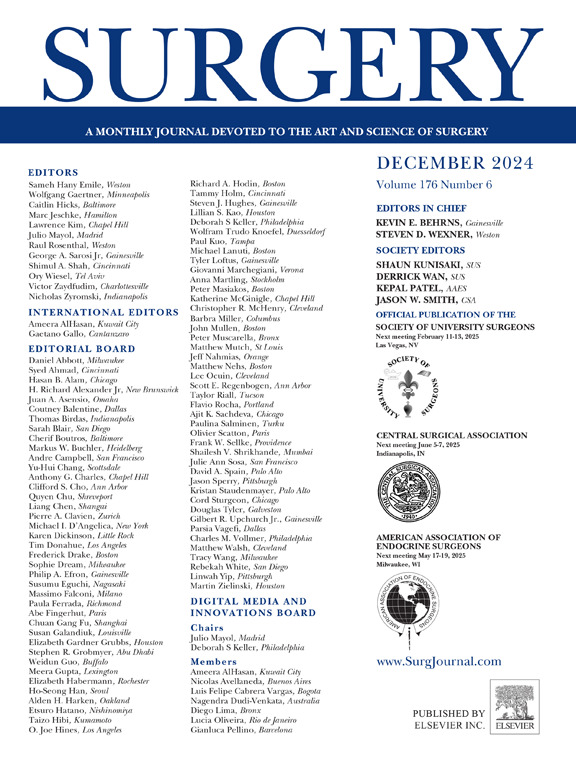Simulation-based training reduces unnecessary ultrasound referrals for developmental dysplasia of the hip in newborns
IF 2.7
2区 医学
Q1 SURGERY
引用次数: 0
Abstract
Background
Developmental dysplasia of the hip is a common newborn condition characterized by malformation or instability of the hip joint. Identifying dysplasia of the hip early is imperative for avoiding long-term consequences. In the United States, dysplasia of the hip screening of newborns uses the Ortolani and Barlow maneuvers. However, evidence suggests that inadequate training in these techniques may lead to unnecessary imaging referrals for further assessment. We investigated the impact of a dysplasia of the hip simulator (MiHip) and its associated training program on ultrasound referral rates and cost-savings at a single institution.
Methods
From July 2021 to June 2022, 54 residents on newborn rotations underwent training using the MiHip curriculum. All newborns born at our institution 1 year prior (n = 5,404) and 1-year posttraining period (n = 5,792) were identified. High-risk factors warranting automatic ultrasound referrals (family history of dysplasia of the hip, breech presentation, and multiple births) were excluded. χ2 tests were used to compare pre- and posttraining incidences of dysplasia of the hip–relevant and unnecessary (defined as dysplasia of the hip–negative) ultrasound referrals. P ≤ .05 was considered statistically significant, and effect, ω ≥ 0.30 considered moderate.
Results
Initial referral rates for dysplasia of the hip decreased by 34.07%, χ2 (1, N = 5,031) = 34.41, P = .02, ω = 0.08. Unnecessary referrals decreased by 23%, χ2 (1, N = 33) = 17.96, P = .04, ω = 0.74. This coincided with a $14,400 annual savings.
Conclusion
The MiHip training curriculum significantly reduced unnecessary ultrasound referrals, demonstrating the value of simulation-based training in enhancing dysplasia of the hip examination skills. This training has the potential to lower financial and emotional burdens associated with extensive imaging, specialist consultations, and follow-up care.

基于模拟的训练减少了新生儿髋关节发育不良的不必要超声转诊。
背景:髋关节发育不良是一种常见的新生儿疾病,其特征是髋关节畸形或不稳定。早期识别髋关节发育不良是避免长期后果的必要条件。在美国,新生儿髋关节发育不良筛查采用Ortolani和Barlow方法。然而,有证据表明,这些技术的培训不足可能导致不必要的影像学转诊进行进一步评估。我们调查了髋关节发育不良模拟器(MiHip)及其相关培训计划对单一机构超声转诊率和成本节约的影响。方法:从2021年7月到2022年6月,54名新生儿轮转住院医师接受了MiHip课程的培训。所有在我们机构出生的新生儿在培训前1年(n = 5,404)和培训后1年(n = 5,792)被确定。排除了需要自动超声转诊的高危因素(髋关节发育不良家族史、臀位表现和多胞胎)。采用χ2检验比较训练前和训练后与髋关节相关的和不必要的(定义为髋关节阴性的)超声转诊的异常发育发生率。P≤0.05认为有统计学意义,ω≥0.30认为效果一般。结果:髋关节发育不良患者首次转诊率下降34.07%,χ2 (1, N = 5031) = 34.41, P = 0.02, ω = 0.08。不必要转诊减少23%,χ2 (1, N = 33) = 17.96, P = 0.04, ω = 0.74。同时每年节省14 400美元。结论:MiHip培训课程显著减少了不必要的超声转诊,证明了基于模拟的培训在提高髋关节发育不良检查技能方面的价值。这种培训有可能降低与广泛的影像、专家咨询和后续护理相关的经济和情感负担。
本文章由计算机程序翻译,如有差异,请以英文原文为准。
求助全文
约1分钟内获得全文
求助全文
来源期刊

Surgery
医学-外科
CiteScore
5.40
自引率
5.30%
发文量
687
审稿时长
64 days
期刊介绍:
For 66 years, Surgery has published practical, authoritative information about procedures, clinical advances, and major trends shaping general surgery. Each issue features original scientific contributions and clinical reports. Peer-reviewed articles cover topics in oncology, trauma, gastrointestinal, vascular, and transplantation surgery. The journal also publishes papers from the meetings of its sponsoring societies, the Society of University Surgeons, the Central Surgical Association, and the American Association of Endocrine Surgeons.
 求助内容:
求助内容: 应助结果提醒方式:
应助结果提醒方式:


